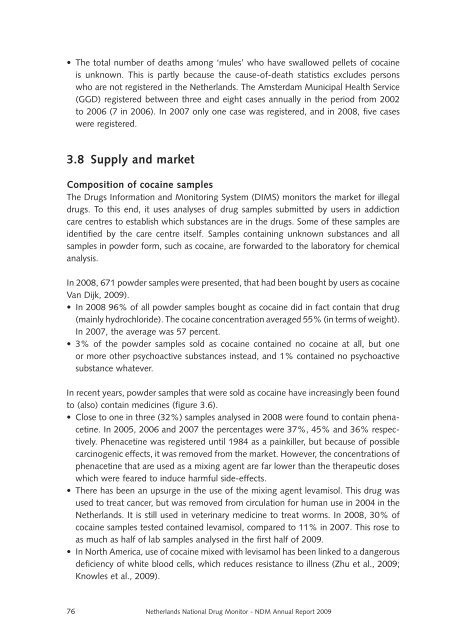Netherlands National Drug Monitor - Research and Documentation ...
Netherlands National Drug Monitor - Research and Documentation ...
Netherlands National Drug Monitor - Research and Documentation ...
You also want an ePaper? Increase the reach of your titles
YUMPU automatically turns print PDFs into web optimized ePapers that Google loves.
• The total number of deaths among ‘mules’ who have swallowed pellets of cocaine<br />
is unknown. This is partly because the cause-of-death statistics excludes persons<br />
who are not registered in the <strong>Netherl<strong>and</strong>s</strong>. The Amsterdam Municipal Health Service<br />
(GGD) registered between three <strong>and</strong> eight cases annually in the period from 2002<br />
to 2006 (7 in 2006). In 2007 only one case was registered, <strong>and</strong> in 2008, five cases<br />
were registered.<br />
3.8 Supply <strong>and</strong> market<br />
Composition of cocaine samples<br />
The <strong>Drug</strong>s Information <strong>and</strong> <strong>Monitor</strong>ing System (DIMS) monitors the market for illegal<br />
drugs. To this end, it uses analyses of drug samples submitted by users in addiction<br />
care centres to establish which substances are in the drugs. Some of these samples are<br />
identified by the care centre itself. Samples containing unknown substances <strong>and</strong> all<br />
samples in powder form, such as cocaine, are forwarded to the laboratory for chemical<br />
analysis.<br />
In 2008, 671 powder samples were presented, that had been bought by users as cocaine<br />
Van Dijk, 2009).<br />
• In 2008 96% of all powder samples bought as cocaine did in fact contain that drug<br />
(mainly hydrochloride). The cocaine concentration averaged 55% (in terms of weight).<br />
In 2007, the average was 57 percent.<br />
• 3% of the powder samples sold as cocaine contained no cocaine at all, but one<br />
or more other psychoactive substances instead, <strong>and</strong> 1% contained no psychoactive<br />
substance whatever.<br />
In recent years, powder samples that were sold as cocaine have increasingly been found<br />
to (also) contain medicines (figure 3.6).<br />
• Close to one in three (32%) samples analysed in 2008 were found to contain phenacetine.<br />
In 2005, 2006 <strong>and</strong> 2007 the percentages were 37%, 45% <strong>and</strong> 36% respectively.<br />
Phenacetine was registered until 1984 as a painkiller, but because of possible<br />
carcinogenic effects, it was removed from the market. However, the concentrations of<br />
phenacetine that are used as a mixing agent are far lower than the therapeutic doses<br />
which were feared to induce harmful side-effects.<br />
• There has been an upsurge in the use of the mixing agent levamisol. This drug was<br />
used to treat cancer, but was removed from circulation for human use in 2004 in the<br />
<strong>Netherl<strong>and</strong>s</strong>. It is still used in veterinary medicine to treat worms. In 2008, 30% of<br />
cocaine samples tested contained levamisol, compared to 11% in 2007. This rose to<br />
as much as half of lab samples analysed in the first half of 2009.<br />
• In North America, use of cocaine mixed with levisamol has been linked to a dangerous<br />
deficiency of white blood cells, which reduces resistance to illness (Zhu et al., 2009;<br />
Knowles et al., 2009).<br />
76 <strong>Netherl<strong>and</strong>s</strong> <strong>National</strong> <strong>Drug</strong> <strong>Monitor</strong> - NDM Annual Report 2009




